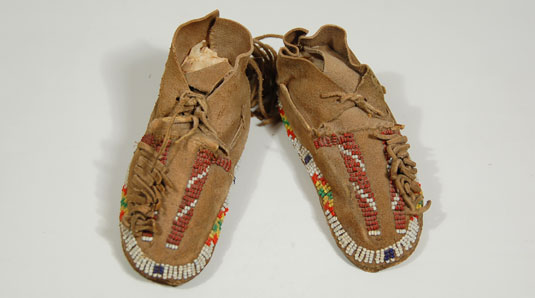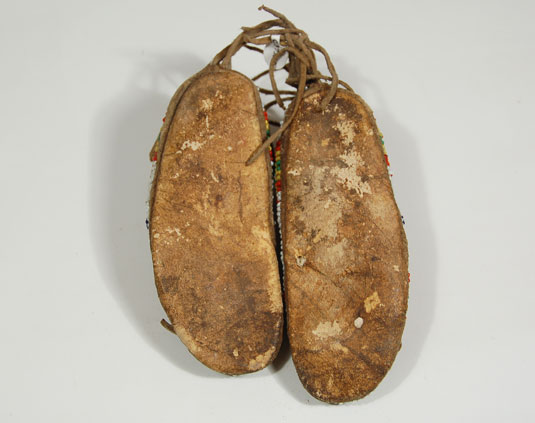Southern Cheyenne Child’s Beaded Moccasins [SOLD]
+ Add to my watchlist Forward to Friend
- Category: Beadwork
- Origin: Cheyenne Nation
- Medium: hide, seed beads
- Size: 5-1/2” long
- Item # C3732C SOLD

A Santa Fe resident recently inherited this pair of child’s moccasins from her dad, who recently passed away, and she is not interested in keeping them because she knows nothing about them and, unfortunately, her dad left no information about them.
I am not familiar with moccasins or with beadwork but I was told by an Indian dealer that these were most likely Southern Cheyenne, so I accept his analysis. The soles show wear patterns. I do not know the age of the moccasins but they were estimated to date to circa 1910.
The Cheyenne (Tsitsistas/The People) were once agrarian, or agricultural, people located near the Great Lakes in present-day Minnesota. The Cheyenne language is a unique branch of the Algonquian language family.
The Cheyenne and Arapaho formed an alliance in the 18th and 19th centuries. Together they were a formidable military force, successful hunters, and active traders with other tribes. At the height of their alliance, their combined hunting territories spanned from Montana to Texas. The Arapaho, also Algonquian speaking, came from Saskatchewan, Montana, Wyoming, eastern Colorado, and western South Dakota in the 18th century. They adopted horse culture and became successful nomadic hunters. In 1800, the tribe began coalescing into northern and southern groups. Although the Arapaho had assisted the Cheyenne and Lakota in driving the Kiowa and Comanche south from the Northern Plains, in 1840 they made peace with both tribes. They became prosperous traders, until the expansion of American settlers onto their lands after the Civil War.
The Cheyenne and Arapaho signed treaties with the United States Government in the mid-1800s that guaranteed rights to traditional lands, however, the government could not or did not enforce any of the treaties and European-American trespassers overran the Indian lands. There were repeated conflicts between settlers and members of the tribes.
The US government brought the tribes to council again in 1867, to achieve peace under the Medicine Lodge Treaty. It promised the Arapaho a reservation in Kansas, but they disliked the location. They accepted a reservation with the Cheyenne in Indian Territory, so both tribes were forced to locate south near Fort Reno in present-day Oklahoma. The Dawes Act broke up the Cheyenne-Arapaho land base. All land not allotted to individual Indians was opened to settlement in the Land Run of 1892. The Curtis Act of 1898 dismantled the tribal governments in an attempt to have the tribal members assimilate to United States conventions and culture.
After the Oklahoma Indian Welfare Act passed in 1936, the Cheyenne and Arapaho organized a single tribal government in 1937. The Indian Self-Determination Act of 1975 further enhanced tribal development.
Condition: very good condition
Provenance: from a resident of Santa Fe who inherited them from her dad’s estate
Reference: Wikipedia

- Category: Beadwork
- Origin: Cheyenne Nation
- Medium: hide, seed beads
- Size: 5-1/2” long
- Item # C3732C SOLD



